Physical Address
304 North Cardinal St.
Dorchester Center, MA 02124
Diseases affecting the peritoneum are diverse, ranging from reactive to neoplastic, the latter being either benign, borderline, or malignant processes. Among malignant tumors, many are of secondary (metastatic) origin; much less commonly, they are primary Müllerian or mesothelial in nature. Entities covered in detail in this chapter include endometriosis, primary peritoneal carcinoma, mesothelioma, pseudomyxoma peritonei, and a small group of unusual tumors such as desmoplastic small round cell tumor (DSRCT) and disseminated peritoneal leiomyomatosis (DPL).
Endometriosis is most commonly diagnosed in reproductive-age women (mean age 28 years) and is the third leading gynecologic cause of hospitalization. The estimated overall incidence is 300 cases per 100,000 person-years, but this varies widely with age, race, history of infertility, and perhaps, body mass index. Disease often manifests with severe dysmenorrhea (50%), pelvic pain (5%–20%) and infertility (up to 20%–30%). The prevalence of endometriosis in asymptomatic patients diagnosed at tubal ligation ranges between 1% and 7%. Less common presentations include cyclic dyspareunia, dysuria, and dyschezia; an extraordinarily rare manifestation is catamenial pneumothorax (spontaneous pneumothorax coinciding with menstruation). Serum CA125 levels may be elevated but not typically to the degree seen in patients with carcinoma.
The most common locations for endometriosis include ovaries, uterine ligaments, rectovaginal septum, and less commonly, pelvic peritoneum, cervix, fallopian tube, vagina, vulva, urinary tract, lymph nodes, umbilicus, gastrointestinal tract, skin (particularly in scars), and lung, among others. The diagnosis is generally made by laparoscopic examination and biopsy.
The overall prevalence of endometriosis-associated carcinoma is <1%, but endometriosis-associated neoplasia (most commonly endometrioid and clear cell carcinoma) is an important problem for gynecologic oncologists and patients alike. It has been reported that the risk for developing ovarian carcinoma is nine times higher in patients with “endometriomas” compared with controls, especially if the size is greater than 9 cm and the patient is postmenopausal.
It has been hypothesized that endometriosis can develop secondary to retrograde menstruation (transtubal dissemination of nonneoplastic endometrium) or metaplasia of other Müllerian epithelium or mesothelium. Interestingly, recent work has suggested that endometriosis may also derive from fallopian tube epithelium. Moreover, oncogenic mutations associated with ovarian carcinogenesis, including ARID1A and PTEN , have been detected in endometriosis without associated cancer, suggesting that at least some types of endometriosis might be neoplastic.
The appearance of endometriosis may vary according to its location (superficial or deep) and duration. Early lesions are most often seen as flat, red, “flame-like” translucent foci or yellow-brown patches. In late stages, red, blue, brown to black patches (so-called “powder burns”), some with a slightly raised or puckered appearance (due to scarring), are characteristic. Especially in the ovary, old endometriosis manifests as an endometriotic cyst (“endometrioma”). The cyst walls are usually thickened with a shaggy brown to yellow lining and filled with dark brown viscous “chocolate-like” material ( Fig. 18.1A ); uncommonly, the cyst contents are clear. It is important to closely examine the wall for nodularity or thickening to exclude a secondary malignancy. Pelvic adhesions, including effacement of the fimbriated ends of the fallopian tubes, are common. In the abdomen, endometriosis may be seen as an irregular thickening, or form an ill-defined, firm mass with a tan/white to brown cut surface, depending on the age of the lesion. When related to prior gynecologic procedures, it typically involves the lower abdominal wall; but if spontaneous, the umbilicus is the most common site. When endometriosis involves the gastrointestinal tract, the most common locations are the rectum/sigmoid, followed by the appendix. The process may be mass forming, sometimes centered in the serosa or within the lumen as a polypoid lesion, the latter a close mimic of a primary colonic malignancy ( Fig. 18.2A ). In some instances, stenosis secondary to scarring and hypertrophy of the muscularis propria occurs. Rarely, prominent cystic change may be seen.
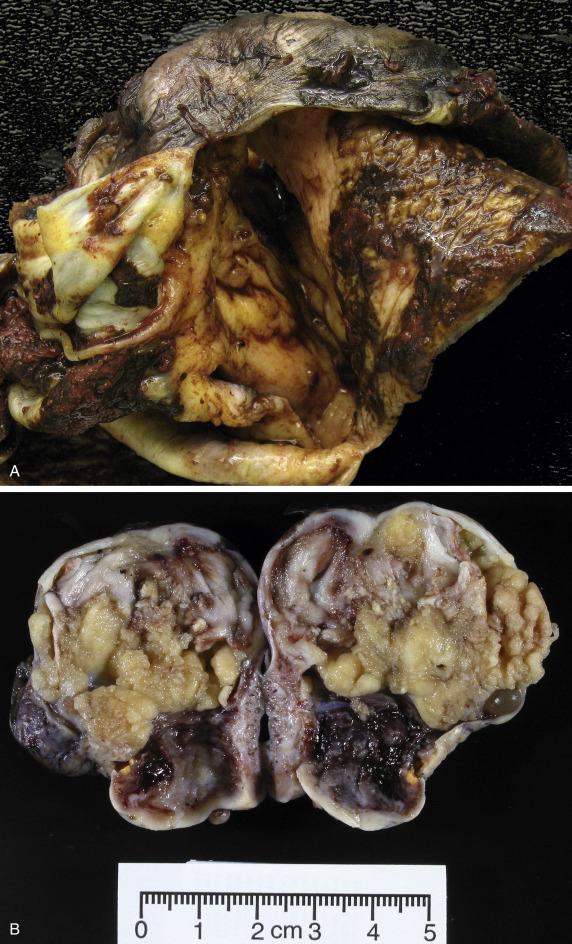

Polypoid endometriosis is seen in the form of large, often multiple polypoid masses that most commonly involve several sites, including colon, ovary and uterine serosa. The lesions can range up to 14 cm, are often partially cystic, and show frequent hemorrhage. Alternatively, endometriosis involves deep structures in the pelvis and abdomen such as intestinal wall (transmural), skeletal muscle, and visceral organs (so-called deep endometriosis). Malignant transformation may take the form of an ill-defined mass distorting or compressing adjacent structures ( Fig. 18.2B ).
Endometriosis can be diagnosed when two of the three following features are present: (1) endometrial-type epithelium, (2) endometrial-type stroma, and (3) recent or old hemorrhage, the latter associated with hemosiderin-laden macrophages ( Fig. 18.3A,B ). The epithelium can display the same range of changes as seen in eutopic endometrium, including squamous, tubal, eosinophilic, papillary syncytial, hobnail, and mucinous metaplasia ( Fig. 18.4A,B ), as well as undergo striking cystic change ( Fig. 18.5 ), hyperplasia ( Fig 18.6A ), or secondary malignant transformation ( Fig 18.6B ). The stroma can also display the same range of changes as seen in eutopic endometrium, including decidual and pseudodecidual changes, smooth-muscle metaplasia ( Fig. 18.7 ), and malignant transformation into sarcoma ( Fig. 18.8 ). Extensive hemorrhage and scarring over a prolonged period give rise to a distinctive associated inflammatory response composed of granulomatous nodules with central necrosis surrounded by a ring of pseudoxanthoma cells, typically with a palisading arrangement (pseudoxanthomatous nodules). In these, endometrial epithelium and stroma are distorted, effaced, or (usually) absent. Uncommonly, endometriosis manifests as stromal-only or stromal-predominant foci, intravascular location, and stromal elastosis and/or myxoid change ( Fig. 18.9 ). Micronodular stromal endometriosis is defined as microscopic (usually 1–2 mm) spherical or occasionally plaque-like aggregates composed of endometrial-type stromal cells with an associated network of small arterioles. Stromal elastosis is defined as aggregates of fibrillary, pink-to-blue/grey material with irregularly shaped contours positive with elastic stain. This is a common finding in pelvic endometriosis and may obscure and even obliterate the endometrial-type stroma. Polypoid endometriosis frequently displays features diagnostic of an endometrial polyp in the eutopic endometrium (fibrotic stroma, thick vessels, glandular irregularity).
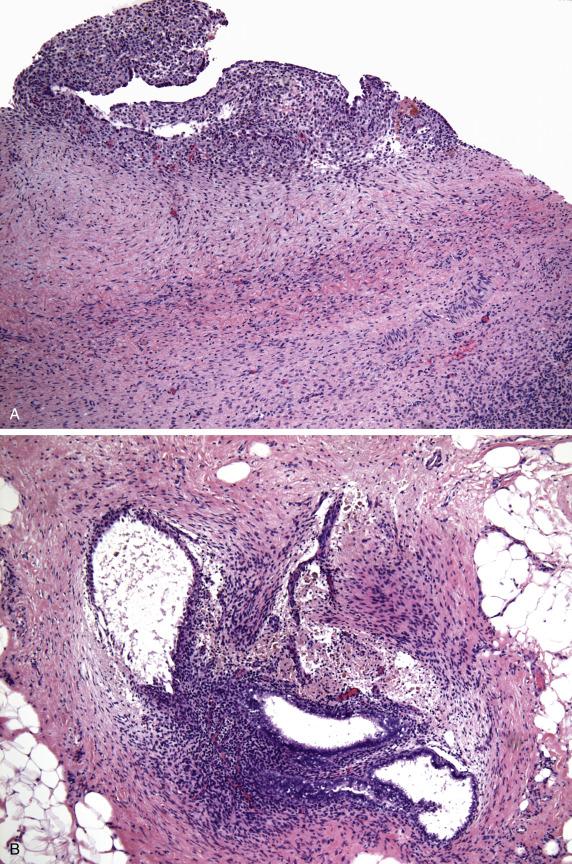
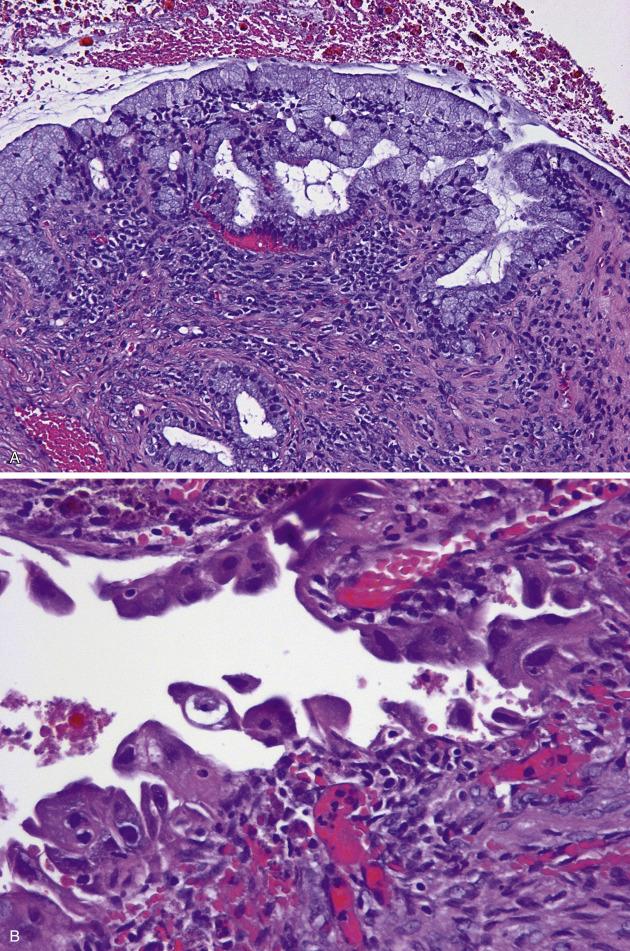
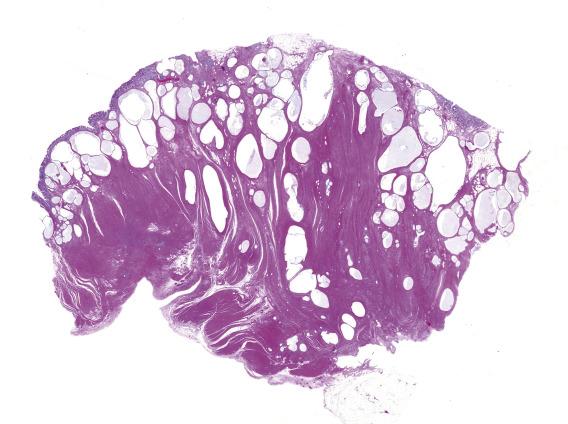
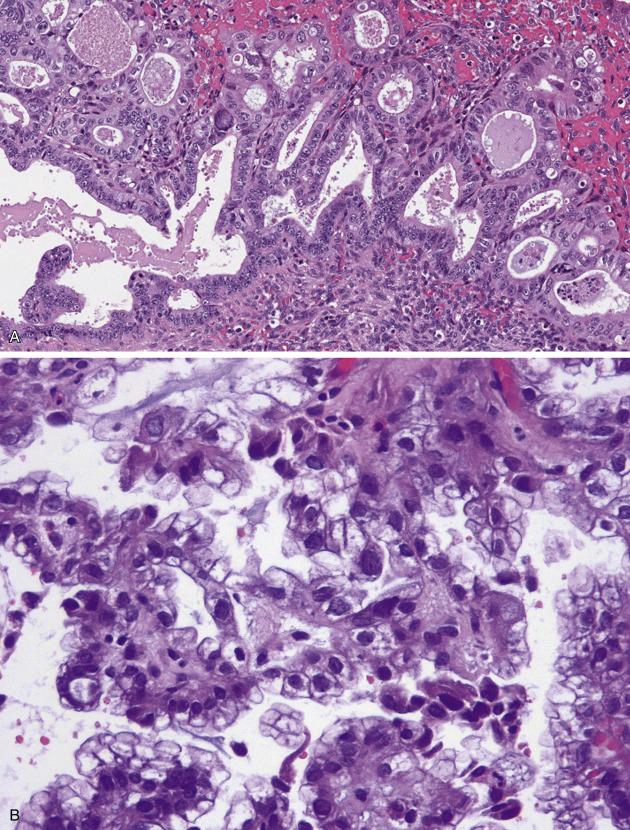

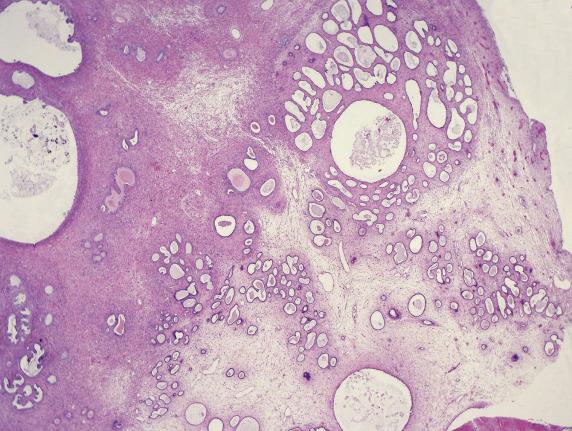
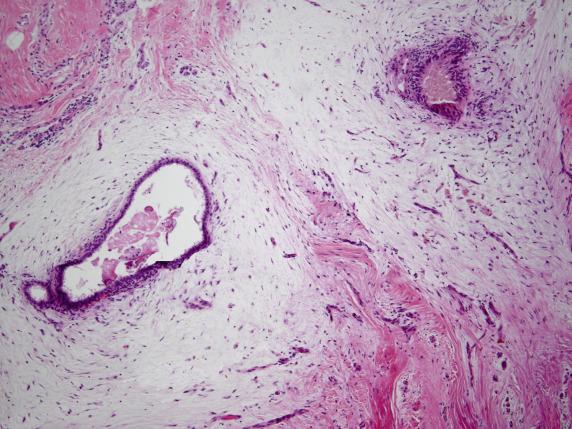
Endometriosis, particularly endometriotic cysts, can display mild degrees of reactive nuclear atypia, seen as enlarged nuclei and cytoplasm (thus, nuclear-to-cytoplasmic ratio remains low), with nuclear hyperchromasia and smudgy chromatin ( Figs. 18.4B and 18.10A ). The so-called “atypical endometriosis” is a term reserved for lesions that display more evident cytologic atypia worrisome for malignancy (usually of the clear cell type) but lack the architectural complexity of carcinoma ( Fig. 18.10B ).
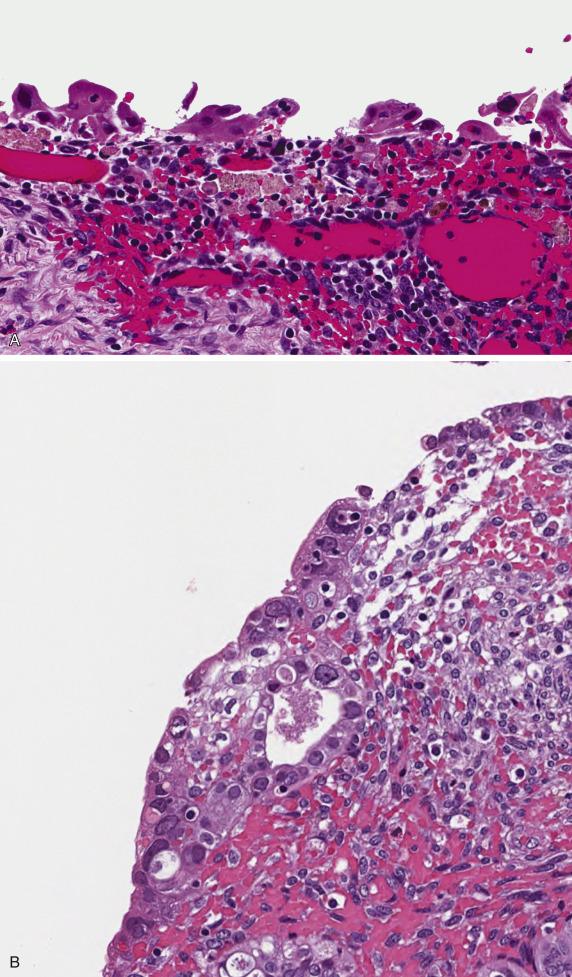
Criteria for diagnosing carcinoma arising from ovarian endometriosis were suggested by Sampson in 1925 and include (1) coexistence of carcinoma and endometriosis in the same ovary; (2) presence of tissue resembling endometrial stroma surrounding characteristic epithelial glands; and (3) exclusion of a malignant tumor metastatic to the ovary. Over the years, pathologists have also included in this category carcinomas or other malignant tumors noncontiguous with endometriosis or present in a patient with history of endometriosis. Carcinomas that develop in endometriosis are most frequently of endometrioid or clear cell type. Some arise in the setting of endometriosis with hyperplasia or endometrioid intraepithelial neoplasia. Others occur in association with atypical endometriosis. Less commonly, mixed Müllerian (seromucinous) borderline tumors may arise from endometriosis, especially within the ovary. Other less common tumors including endometrioid stromal sarcoma, Müllerian adenosarcoma, and carcinosarcomas have also been described.
The endometriotic epithelium is positive for keratins, PAX8, vimentin, estrogen receptor (ER), and progesterone receptor (PR). The stroma is positive for CD10, IFITM1, ER and PR; desmin and keratin expression is variable (usually not diffuse). Cell proliferation by Ki67 is variable.
Endometriosis should be distinguished from endosalpingiosis, metastatic adenocarcinoma, endometrioid stromal sarcoma, and adenosarcoma. Endosalpingiosis is composed of bland cells (with variable number of ciliated cells) resembling fallopian tube epithelium. It generally appears as single or small clusters of glands and is typically not mass-forming. Endometriotic glands frequently have tubal differentiation; thus, the diagnosis of endometriosis more commonly relies on the presence of endometrial-type stroma and hemosiderin, which are absent in endosalpingiosis. However, in postmenopausal patients, the endometrial stroma may be sparse or absent; in this difficult instance, the presence of small arterioles around the glands is a helpful clue. Endometriosis may be confused with metastatic adenocarcinoma as the former may be associated with fibrosis, elastosis, and/or myxoid change conferring a “pseudo-infiltrative” appearance to the glands. The glands may also show irregular contours secondary to the stromal changes and also display mitotic activity; however, endometriosis lacks overt cytologic atypia and malignant growth (solid, papillary, confluent glandular).
Caution is advised when evaluating glandular tumors centered in the gastrointestinal tract wall: endometriosis (more often polypoid) and carcinomas associated with endometriosis may be misdiagnosed as a primary colorectal carcinoma as both may be mass-forming and protrude into the lumen. The findings of squamous metaplasia, serosal or deep intramural location, lack of CK20 expression, PAX8 positivity, conventional endometriosis, and absence of intestinal mucosal dysplastic changes all favor endometriosis or endometriosis-associated malignancy over a colorectal adenocarcinoma. When endometriosis is present within the appendiceal wall, distinction from a primary appendiceal mucinous neoplasm may be difficult as endometriosis at this site has been reported to exhibit intestinal metaplasia. Distinction is aided by the finding of conventional areas of endometriosis, as well as associated muscle hypertrophy and elastosis.
Stromal-predominant and intravascular endometriosis can resemble metastatic endometrial stromal sarcoma or primary endometrioid stromal sarcoma arising in endometriosis . Clinical history and imaging can frequently aid in this distinction. Features favoring endometriosis include the presence of widely distributed endometrioid glands (although rare stromal sarcomas may have them, usually as a very minor component) and absence of a stromal-predominant mass with infiltrative margins. Polypoid endometriosis can mimic primary or metastatic Müllerian adenosarcoma ( Fig. 18.11 ). The findings of intraglandular polypoid projections and prominent stromal cuffing around the epithelium are diagnostic of adenosarcoma. Many, but not all, of these tumors also show mitoses within the stroma (two or more per 10 high power fields [HPFs]), cytologic atypia ranging from mild to severe, and sarcomatous overgrowth (more than 25% of the tumor volume composed of pure sarcoma).
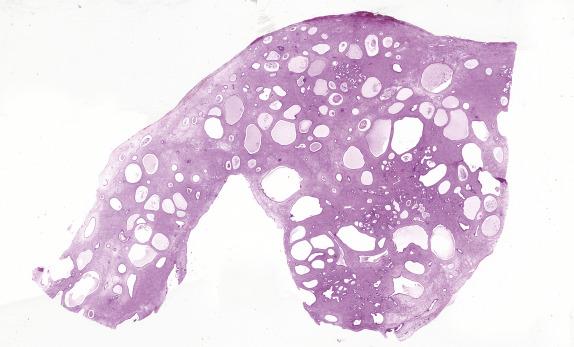
Endometriosis is a chronic disease; thus, complete regression or physiologic atrophy is hard to obtain. Medical treatment alone using oral contraceptives, androgenic agents, progestins, and gonadotropin-releasing hormone (GnRH) analogs frequently reduces pain and the extent of disease, but greater than half of patients experience recurrence(s) following cessation of treatment and side effects are common. Surgical ablation of endometriotic lesions followed by medical therapy decreases recurrence rates and improves symptom-free intervals following therapy. Surgical ablation and pelvic anatomy restoration are recommended for infertile patients with mild to moderate endometriosis, and as many as 30% have become pregnant within 36 weeks of treatment. Reversal of infertility is extraordinarily difficult in patients with severe endometriosis.
Endometrial type glands and/or stroma in ectopic locations
300 cases per 100,000 person-years (varies widely with age, race, history of infertility, and perhaps, body mass index)
Prevalence between 1% and 7% in asymptomatic patients
Most common locations: ovaries, uterine ligaments, and rectovaginal septum
Third leading gynecologic reason for hospitalization
Important cause of infertility, dysmenorrhea and pelvic pain
Can develop secondary malignant neoplasms
Peak age 25–29 years
Severe dysmenorrhea (50%), pelvic pain (5%–20%) and infertility (20%–30%)
Serum CA125 levels ± elevated
Secondary (sometimes ominous) symptoms/signs if associated with malignancy
Oral contraceptives, androgenic agents, progestins, and GnRH agonists for reduction of pain and extent of lesions
Complete regression is rarely achieved
Common recurrences (∼half of patients) following treatment cessation
Decreased recurrence rates and improved symptom-free intervals following surgical ablation and medical therapy
Surgical ablation and pelvic anatomy restoration recommended for infertile patients with mild to moderate endometriosis (up to 30% become pregnant within 36 weeks of treatment)
If severe endometriosis, reversal of infertility is very difficult
Polypoid, nodular, plaque-like, cystic, and/or solid ± scar tissue
May form “chocolate” cysts with dark brown, sometimes viscous contents
“Powder burn” spots or “mulberry lesions” if remote
Common pelvic inflammation and scarring leading to pelvic and tubo-ovarian adhesions and effacement of fimbriated end of fallopian tube (with subsequent infertility)
Diagnostic triad: (1) endometrial-type glands/epithelium, (2) endometrial-type stroma, (3) recent or old (hemosiderin deposition) hemorrhage (two of three required)
Endometrial-type epithelium and/or stroma can display metaplastic and hyperplastic changes as seen in eutopic endometrium
Extensive hemorrhage and scarring over prolonged time period can be associated with secondary fibroblastic and inflammatory response (necrotic pseudoxanthomatous nodules) in which endometrial-type epithelium and stroma are absent
Polypoid endometriosis: appearance reminiscent of endometrial polyp
Deep endometriosis (involving viscera walls, skeletal muscle)
Mass-forming
Micronodular endometriosis: small nodules (usually 1–2 mm) composed of endometrial stroma only
Stromal elastosis and myxoid change
Metaplasias, including intestinal (especially if appendiceal)
Atypical endometriosis: cytologic atypia in the absence of architectural complexity and frank malignancy
Secondary mesothelial hyperplasia in areas of adhesions may be striking
Secondary tumors, most commonly endometrioid and clear cell carcinoma; less often mixed Müllerian (seromucinous) borderline tumor, endometrioid stromal sarcoma, and Müllerian adenosarcoma
Epithelium: PAX8, PAX2, keratins, vimentin, ER, PR positive
Stroma: CD10, IFITM1, ER, PR, SMA positive; ± desmin and keratin
Endosalpingiosis
Metastatic adenocarcinoma
Endometrioid stromal sarcoma
Müllerian adenosarcoma
Broadly, the term “primary peritoneal carcinoma” refers to serous carcinoma arising from the peritoneum. The vast majority are high grade, although low-grade serous tumors are also included.
Regarding high-grade serous carcinomas, growing evidence has revealed that many, but not all, of these tumors have an associated early high-grade serous carcinoma in the fallopian tube (serous tubal intraepithelial carcinoma [STIC]) and therefore are most likely tubal primaries with peritoneal involvement. By recent definitions, the diagnosis of primary peritoneal carcinoma requires that (1) the mass is situated in the pelvic or abdominal peritoneum and (2) the ovaries and tubes are entirely available for pathologic examination and free of serous carcinoma (including absence of STIC). Deposits on the tubal serosa are exempt from this rule, and in the absence of tubal mucosal involvement, they can be seen in primary peritoneal carcinoma. Under the same logic, one could argue that a dominant peritoneal tumor with microscopic (<5 mm) ovarian surface involvement could theoretically represent a peritoneal primary as well (in keeping with previous definitions of primary peritoneal carcinoma).
Although patients present at a slightly older age compared to those with primary tubo-ovarian carcinoma (61 vs. 56 years), the clinical presentation is identical. The most common complaints, which are nonspecific, include fullness, bloating, increasing abdominal girth, and constipation. Patients frequently have palpable abdominal and pelvic masses on physical exam, and many have ascites. Less commonly, pleural effusions and palpable supraclavicular or inguinal lymphadenopathy are noted, and serum CA125 levels are generally elevated. A rare manifestation is a hypercoagulable state manifested by deep pelvic vein thrombosis and pulmonary embolism. Approximately 5%–10% of all primary peritoneal carcinomas are related to inherited BRCA1 mutations; in patients carrying these mutations, the lifetime incidence of primary peritoneal carcinoma is low compared to high-grade tubo-ovarian serous carcinoma but higher than in the general population (∼2%).
Low-grade serous carcinomas may have a similar presentation, but not uncommonly, they are discovered as an incidental finding in patients being worked up for infertility or other reasons. Pelvic ultrasound and serial CA125 levels are relatively nonspecific screening tools that may help stratify patients who deserve further evaluation.
Primary peritoneal carcinomas present with an omental “cake,” miliary studding of peritoneal surfaces, and/or discrete peritoneal masses ( Fig. 18.12 ). High-grade serous carcinomas typically produce omental caking and studding with irregular borders and infiltration of omental adipose tissue and abdomino-pelvic organs ( Fig. 18.13 ). Low-grade carcinomas may present in a similar fashion but are usually less bulky and tend to manifest with striking serosal adhesions.
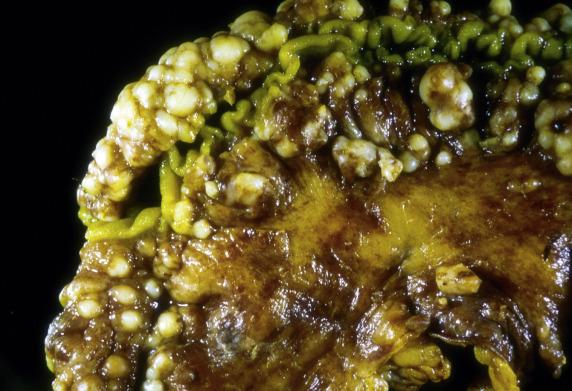
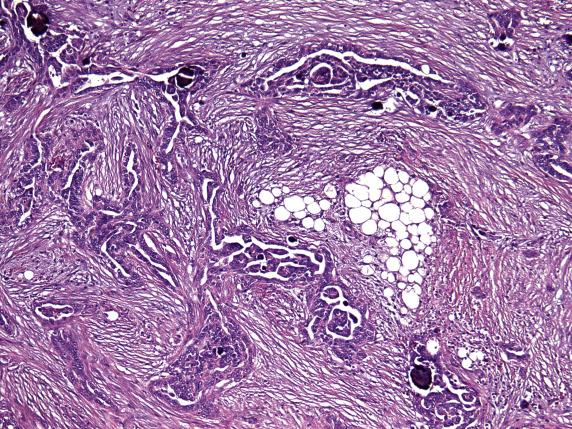
The histologic appearance of high-grade serous carcinoma is identical to that seen in the ovary and tube, characterized by classic complex papillary and glandular structures. Cell stratification and loss of polarity are prominent, imparting a complex branching architecture to the papillae and narrowing of the glandular lumens (seen as slit-like spaces). Less conventional architectural patterns, now recognized as part of the spectrum of high-grade serous carcinoma, include solid, pseudo-endometrioid, and transitional-like (grouped as “SET” morphology, more common in patients with BRCA mutations). On high-power examination, there is marked nuclear pleomorphism (three or more times variation in nuclear size) and easily identified atypia in the form of large nuclei with high nuclear-to-cytoplasmic ratio, coarse chromatin, and prominent cherry nucleoli. Brisk mitotic activity (≥12/10 HPFs) and a high number of apoptotic bodies are characteristic ( Fig. 18.14 ). Necrosis is usually present and can be extensive. Tumor usually elicits a prominent desmoplastic response.
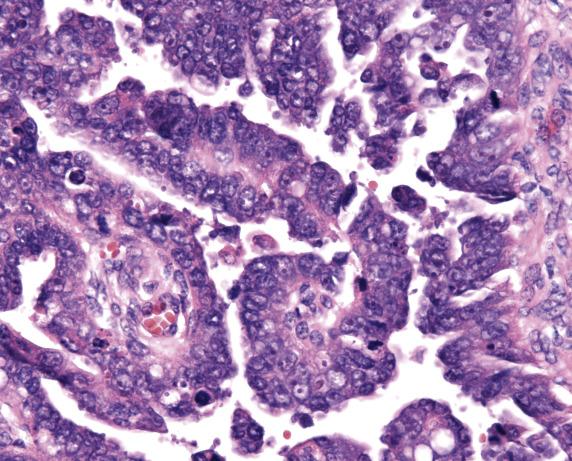
Low-grade serous carcinomas are composed of delicate, small cellular papillae or solid nests in spaces that may be confluent and involve the peritoneal surfaces (including within adhesions) or invade underlying tissues ( Fig. 18.15A,B ). They display cuboidal or columnar cells that have low-grade cytologic features (less than three times variation in nuclear size) and low mitotic rate (<12/10 HPFs). A rare variant of low-grade serous carcinoma with abundant psammoma bodies, so-called psammocarcinoma, is characterized by large numbers of psammoma bodies (>75% of tumor) with cell nests containing less than 15 to 20 cells.
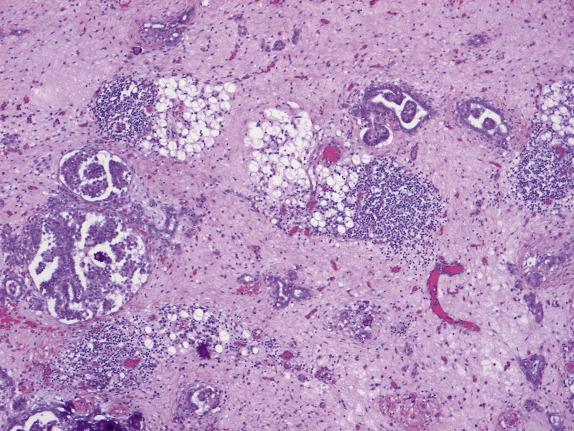
Low- and high-grade serous carcinomas express pancytokeratins, CK7, CA125, PAX8, PAX2, MOC31, BerEP4, B72.3, WT1, ER, and PR. Calretinin is either negative or shows patchy positivity. Low-grade serous carcinoma may express cytokeratin 5/6 as well as p16 (although typically not diffuse). High-grade serous carcinoma typically shows strong and diffuse p16 positivity and abnormal p53 expression, either strong diffuse (>80%) or complete absence (null pattern). Ki67 index is typically much higher in high-grade (>70%) compared to low-grade serous (<30%) carcinomas.
The differential diagnosis includes metastatic tubal/ovarian and endometrial serous carcinoma (if high grade), primary peritoneal serous borderline tumor or implants of an ovarian serous borderline tumor (if low grade), mesothelioma and metastatic papillary neoplasms (for both low- and high-grade carcinomas). The morphologic appearance of high-grade serous carcinoma is similar in different locations of the female genital tract; thus, the most helpful finding in assigning a primary site is to identify a serous intraepithelial carcinoma (STIC) in the fallopian tube or a bulky tumor within the fallopian tube, ovary, or endometrium. Current site assignment recommendations indicate that, in the presence of STIC and/or carcinoma in the tube, the tumor should be classified as tubal. As outlined earlier, primary peritoneal origin should be considered only in the absence of tubal carcinoma and ovarian involvement. WT1 expression in peritoneal tumors is similar to that seen in their tubal/ovarian counterparts but contrasts with most endometrial carcinomas , which typically lack diffuse WT1 expression.
Low-grade serous carcinoma should be distinguished from peritoneal serous borderline tumor ( Fig. 18.16 ) and ovarian borderline tumor with implants . In the latter scenario, the ovary(ies) has obvious replacement by tumor. By convention, an invasive low-grade peritoneal tumor that coexists with an ovarian borderline tumor is considered to be of ovarian origin. Invasive implants of a serous borderline tumor of the ovary very closely resemble the appearance of a primary peritoneal serous carcinoma. Although the use of the term “invasive implant” is widely accepted among pathologists, for treatment purposes, invasive implants are equivalent to low-grade serous carcinoma.
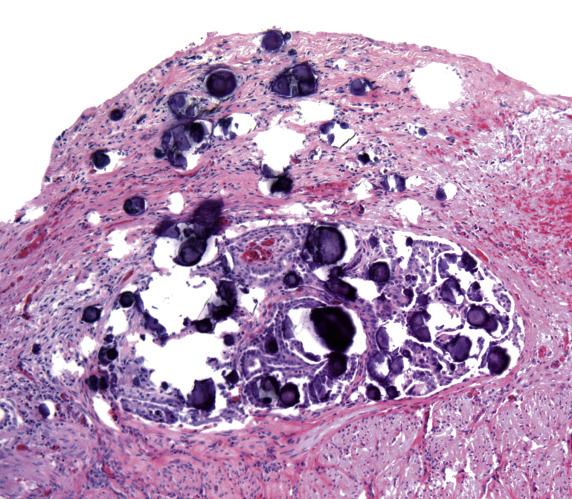
Mesotheliomas , particularly when papillary, can enter in the differential diagnosis of either low- or high-grade serous carcinomas. The low-power architecture, showing relatively delicate papillae as well as uniform cytology, is more akin to low-grade serous carcinoma; however, they typically lack hierarchical branching or cell budding. Tubular and solid growths are also commonly seen, which are rare in low-grade serous carcinoma. High-grade peritoneal serous carcinomas are characterized by poorly formed glands, irregularly shaped papillae, and slit-like spaces, which contrasts with the more orderly papillary arrangement of mesothelioma. Moreover, the high-grade cytologic features and brisk mitoses are beyond that expected for mesothelioma. Although psammoma bodies can be seen in both, they are more common in serous carcinomas. Their immunophenotype also differs as mesotheliomas express calretinin (serous tumors can show focal expression; negative staining typically excludes the diagnosis of mesothelioma) and show loss of BAP1 (in ~65% of the peritoneal mesotheliomas; BAP1 loss virtually excludes other diagnoses). Mesotheliomas are also D2-40 positive and ER negative, whereas serous carcinomas express MOC31, BerEP4, B72.3, and ER but are negative for D2-40. Of note, although PAX8 was thought initially to be helpful in this differential diagnosis (favoring Müllerian origin), it has been recently shown that mesotheliomas can sometimes also strongly and diffusely express this marker; thus, a panel of markers should be performed. The differential diagnosis may rarely include papillary tumors metastatic to the peritoneum, such as papillary thyroid carcinoma (originating in struma ovarii), metastatic retiform Sertoli–Leydig cell tumor, and metastatic yolk sac tumor. In patients with a concurrent struma ovarii, careful examination of the ovarian and peritoneal tumors is necessary, in order to exclude the possibility of a thyroid neoplasm spreading to the peritoneum. Thyroglobulin and TTF1 expression should raise this possibility, of course, in the context of the appropriate morphologic features indicative of thyroid malignancy (nuclear morphology in papillary thyroid carcinoma, definitive infiltration in the exceedingly rare case of a follicular carcinoma). Retiform Sertoli–Leydig cell tumors and yolk sac tumors occur in pediatric and young patients and may rarely enter in the differential diagnosis of a borderline or low-grade serous carcinoma. However, they are associated with a unilateral ovarian mass and a distinctive immunophenotype (inhibin, FOXL2, and SF1 for Sertoli–Leydig cell tumor; SALL4 and Glypican-3 for yolk sac tumor).
Primary peritoneal carcinoma has a prognosis that overlaps with, or is the same as, tubal/ovarian carcinomas of similar histologic grade. This is reflected in the latest American Joint Commission on Cancer and International Federation of Gynecology and Obstetrics staging systems, which now have a unified staging scheme for ovarian, tubal, and peritoneal carcinomas. The most important prognostic factors include stage, grade, debulking status, and response to chemotherapy. The mean 5-year survival rate is approximately 40%. Primary therapeutic modalities include neoadjuvant intravenous chemotherapy containing platinum- and taxane-based agents or optimal tumor debulking followed by intraperitoneal and intravenous chemotherapy.
Currently defined as a Müllerian serous carcinoma in which:
Dominant mass located in the abdominal or pelvic peritoneum
Ovaries are normal (some would accept microscopic <5 mm tumor on the ovarian surface)
Absence of STIC or invasive carcinoma in the fallopian tubes
Includes high-grade (vast majority) and low-grade serous carcinoma
Uncommon; as most peritoneal carcinomas are now regarded as metastatic from fallopian tube and, much less commonly, endometrium or ovary
Lifetime incidence <0.5% in general population
In patients with germline BRCA-1 mutations, lifetime incidence of nearly 2%
5%–10% of all primary peritoneal carcinomas are hereditary (inherited BRCA-1 mutations)
Become a Clinical Tree membership for Full access and enjoy Unlimited articles
If you are a member. Log in here